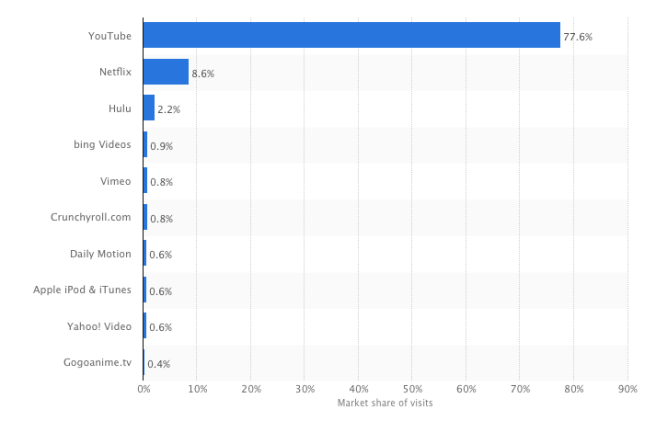Humanity has been watching TV since the 1940s. Back then everything was black and white, the introduction of color broadcasting started a couple of years later. Since that point, there really has not been any significant progress of the whole concept “watching TV”. Yes, we have broadcasts in 1080p now and our televisions look nice and sleek now, but the general concept stayed the same. You choose a particular channel and watch whatever the show producers come up with.
Not surprisingly, more and more people are turning away from traditional TV consumption towards online streaming services. This trend is especially visible in the 16-24 yrs. age segment. As a result, TV channels find themselves in a difficult position. Should they embrace the fact that their audience is shifting more towards older people? Or should they use their limited broadcasting time to retain the young demographics?

Let’s look at their biggest competitor: online streaming services.
Currently, the US video streaming market weighs $6.62 billion and over 85% of all broadband households subscribe to at least one offering (Netflix being the market leader). When it comes to non-subscription based online services, YouTube exceeds the reach of Netflix by an order (!) of magnitude (see graph below).

So, what happens when the TV industry tries to cope with the threat of Netflix and Youtube?
YouTube TV
A few days ago, Google announced that they are partnering with major US broadcasters to create an online streaming service for watching live TV. Costing $35 a month, the service allows customers in selected US cities to watch channels on all their devices and even record shows for delayed entertainment.
To me, Youtube TV appears to be a (desperate) effort of the TV industry to stop young people from completely turning their back on traditional TV. In my opinion, they have missed the opportunity of transitioning to digital platforms themselves. Most of their own digital services (Facebook Groups, Smartphone Apps, Websites) are not designed with the wants of our generation in mind. Thereby, they fail to create a social component that retains viewers.
Still, it might be that the overall concept of having limited ability to choose content is just outdated. If that’s the case, then they will have a hard time competing long-term with experienced video-on-demand services such as Netflix or Amazon Video.
Where do you think the TV industry is heading? Can services such as YouTube TV help to make traditional TV more relevant to you? Would love to hear your opinions in the comments!
Hey awesome post! I didn’t even know about YouTube TV, it seems kind of redundant though… I’m only saying this because I still very much enjoy watching TV shows etc on a larger screen such as my laptop (at least), or connecting my laptop to my TV and watch shows through there. So I guess in a way I’m still using my TV haha
But nonetheless, more than half the time I find myself still turning on the TV to have in the background, but still watching/doing something on my laptop – maybe because I grew up always having the TV in the background… In terms of focusing on older demographics, I think the reason they don’t really watch anything on the television is because there aren’t any shows catered to them, so it would be a really good demographic to target (but thats something for show producers to figure out)
LikeLiked by 1 person
Thanks for sharing your opinion, Aliyah!
I totally agree with you. In my opinion, the TV device itself is transforming from being solely used for watching TV to being the hub of several different input sources. People now connect their laptops to it (like you said) or buy a Chromecast or Apple TV and then watch YouTube or the latest vacation pictures on it.
I guess if this trend of less and less young people watching TV continues, TV producers are forced to focus on older demographics. But again, this will be like a death spiral because as a result even less young people are tuning in. The aging of the population in western countries supports this development even further.
LikeLike
In today’s marketing environment, I feel that people like choice and control And the biggest shift for traditional TV is that they used to be in control, but now the consumer is in control. The value proposition of traditional television has been to cater for a very diverse audience, produce unique content and provide high-quality journalism.
TV stations aim to be “everything for everybody”. While this has made sense in the past, it is questionable whether this still appeals to the media and technology savvy viewers of today. Therefore, with streaming services such as Netflix, Amazon Prime or Apple TV allowing consumers to control their viewing content, I do feel that the future of traditional TV looks bleak.
LikeLiked by 1 person
Thanks for your comment!
I honestly can’t think of any advantages that traditional TV has over customizable online content. Except for live sports or events, I hardly ever watch TV. I acknowledge that there are certainly differences in viewing habits across the demographics, but in terms of our generation, I am totally on your side: traditional TV consumption is moving towards zero.
LikeLike
I think the TV industry will always be here to stay. People watch the news, people prefer to watch sport on TV (look at the outrage of Optus with the EPL rights) and people prefer to watch something that doesn’t require effort to search. I have a netflix account, but it’s my go to when there’s nothing on TV. Maybe the TV stations should start looking to fulfilling the needs of the viewers, instead of re-hashing old movies and tv shows?
LikeLike